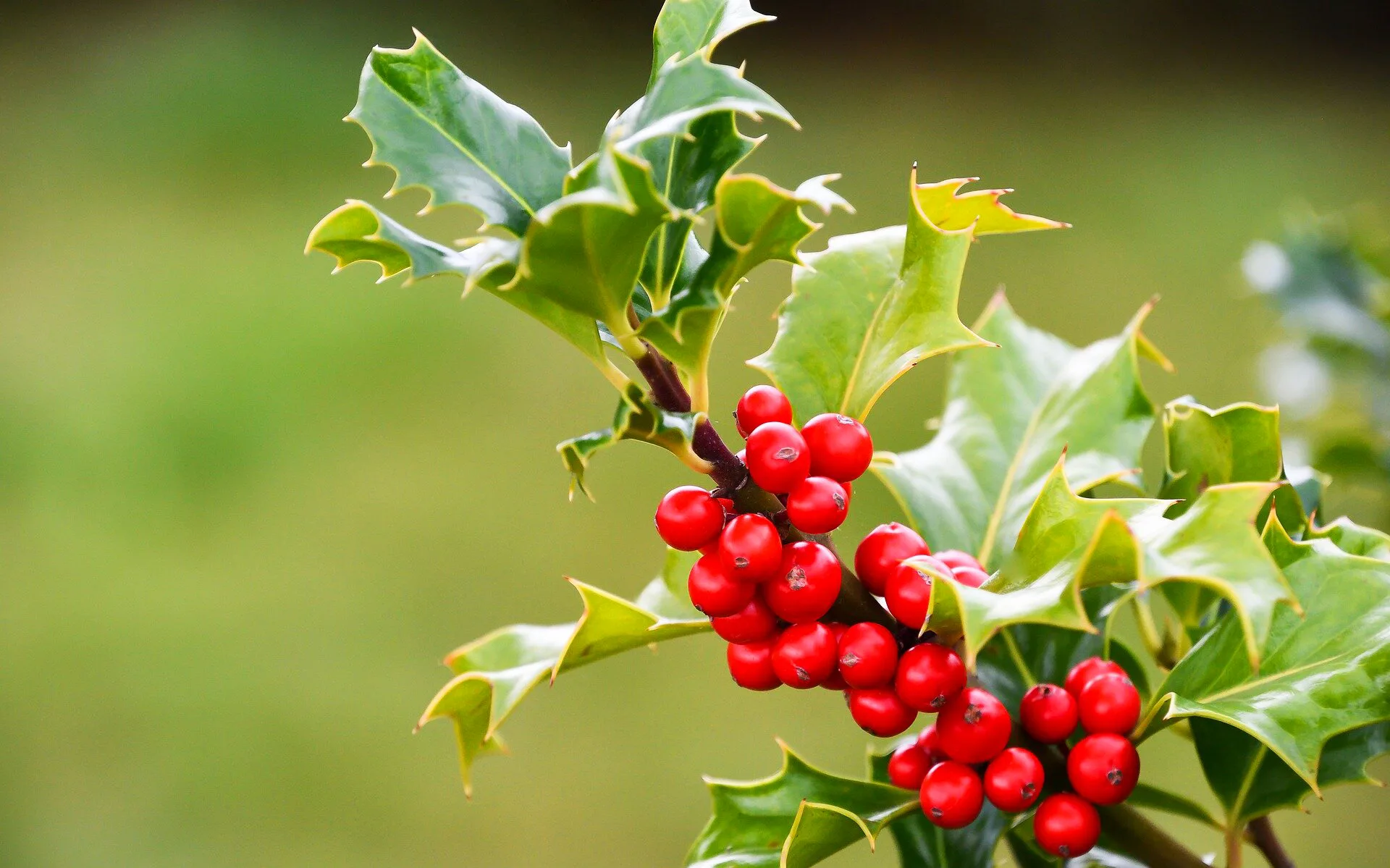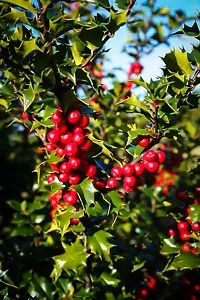
Written by davethetreecenters • August 31 Why Does My Holly Tree Have No Berries?
There is no doubt that holly bushes are super-popular, not just for their dense, glossy foliage, but especially for their bright red berries, that brighten the holiday season. Yet in garden after garden across the country no berries are to be seen. The picture on the label – and may even the plant itself it you bought it in fall – shows big, bright bunches, but since you planted it nothing has happened, or at most a few sad little berries appeared one year. The answer is not simple, so let’s explore the problem, and find an answer to this annual bringer of disappointment instead of winter cheer.
5 Reasons Your Holly Has No Berries
- It is still too young
- It doesn’t have enough sun to flower
- You trim it a lot between spring and fall
- You have a male tree
- You have a female tree, but no suitable male
The Birds and Bees of Holly Bushes
The first thing to understand is that the picture you might have learned in school Biology class of a flower is not always true. That one you looked at – with its stamens and pistils – is called a ‘perfect’ flower. It has both male parts, the stamens that produce pollen, and female parts, the stigma to catch the pollen, and the ovary below it to produce the seeds. Most plants do have flowers of this kind, but not all. (Even then, many plants can’t pollinate themselves, but that’s a different story.) Holly trees have their male parts on one tree, and the female parts on another one. Trees like that are called ‘dioecious’, pronounced, die-ee-shush, while those perfect flowers are on ‘monoecious’ trees – an apple tree would be a good example of that.
So that great holly bush you bought that was supposed to have lots of berries is going to be a female tree, and without a male around it won’t be able to form any berries, no matter how much it flowers. This is the simple answer to the question – no male, no berries. “Hi, what’s a nice bush like you doing in a garden like this?”
Some Practical Reasons You Don’t Have Berries
Before blaming the problem on your tree not getting out enough, there could be other reasons to do with the growing conditions. First of all, your tree could be too young. There is no age of consent for holly trees, but when they are young, and you are feeding and watering them a lot, they can simply be too busy making lots of new growth to get round to flowering. Even if a bush had berries when you bought it, once it gets growing, it might not bloom again for several years. So first, check for blooms in spring – no blooms mean no berries.
Second, it could be the growing conditions. Too much shade will reduce flowering for most trees, and although holly bushes tolerate a lot of shade, it will reduce or eliminate flowering. When planting with berries in mind, a minimum of sun in the mornings is best.
Third – and this is a common reason – you might be trimming them off. Since your tree blooms in spring, if you go out in spring and do a big trimming, the chances are you will remove many, and even all, of the flowers or berries. The correct time to trim is later, once new stems have grown out. Those can be trimmed, but try to leave a few inches of them, because they are the places that flowers will form next spring. As well, lots of trimming encourages lots of fresh, young growth, and those stems don’t flower much. This is especially a problem if you have a contractor doing your garden, as they often trim everything in sight. So have a word with them and make sure they spare the holly trees.
How to Check for Blooms – and then Sex them
Holly trees flower in spring, and it can be easy to miss the flowers, because they are small and white. Some holly trees have profuse flowering that is pretty conspicuous, and popular with bees too, but most are pretty shy, and the flowers are not very obvious. Look for them in spring tucked among the leaves, looking at first like greenish, knobbly stems, and then opening into small flowers with greenish-white petals. The photo at the top of this blog shows the differences well – these were taken on the first of May in Arkansas. On the right is a male tree, and on the left a female one. Notice the four stamens on the male flower, tipped with yellow pollen – it will come off on your finger if you stroke them. The female flower has stamens too, but they have no pollen, and they are smaller. See the green structure in the center of the female flower? That is the potential berry, with a rough top – the stigma – to catch the pollen. You might need a hand-lens (or the close-up on your camera) to see all this.
If, when you look at your tree, you see male flowers, then that is another reason you don’t have berries – male tree, no berries. Don’t despair though, because now you have a male that will pollinate several female trees you can now go out and buy.
“But I Was Told My Tree Didn’t Need to be Pollinated”
That could be true, but holly bushes that do that are rare. Some female trees are able to ripen berries that have no seeds in them (called ‘parthenocarpic’) even without pollination. While several types can do this to a degree, the best and most reliable is the Foster Holly (Ilex x attenuata ‘Fosteri #2’), so if you bought that one, what you were told was certainly true. The Foster Holly is definitely the one to go for if you only have space for a single tree.
The second reason this could have been true is that you bought a combination tree. This is one where a male and female are planted in the same pot. This is often done with blue holly (Ilex x meserveae), where the choice of male has to be precise – look for a combo ‘Blue Princess’ and ‘Blue Prince’. It is also done with deciduous holly, the Winterberry (Ilex verticillata), where again precision in matching is important. The danger with these trees is that you accidently prune out the male tree, so examine your plant closely, and make sure you keep both parts growing well.
Plant a Suitable Male Tree
Now we can see that the answer is simple – add a male tree (or 2 or 3) to your garden collection. Many are excellent foliage plants, and well worth growing for that alone. You only need one male tree for 5 to 7 female bushes, so when planting a screen or hedge, tuck a few into the row as you go along. Otherwise, if they are within 100 feet or so, you will soon have the berries of your dreams on your female trees.
Some male trees are better than others – they pollinate a wide range of different species and hybrid females. The Blue Prince Holly is one, and the American holly variety called ‘Jersey Knight’ is another. With those in your garden you should be all set for most female trees. Some – the longleaf holly, Ilex latifolia, for example – are best pollinated with a male of their own species, but most female trees are not so particular. To end with the inevitable next question, if you have a single tree that berries every year (and it isn’t a Foster Holly) it is likely the simple reason is that a neighbor has a male tree that is doing the job.
***If you want to check the availability of any of the plants mentioned here, go to our Home Page, click on the ‘Search’ button in the upper right, and type in your choice – both common names and botanical ones will work. If, sadly, you find the item sold out, click on the ‘notify me’ box beside the size you want, and you will get an email the moment that plant is available again – it’s easy.






